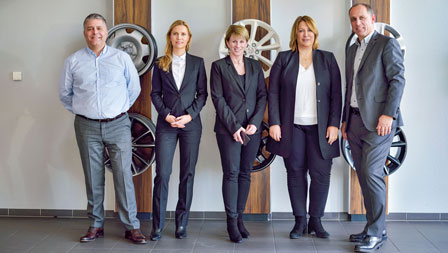A visit to Salzgitter customer Maxion Wheels
29.05.2019 | Salzgitter Flachstahl GmbH
Inside the wheel factory

A visit to Salzgitter customer Maxion Wheels in Königswinter delivers two surprising facts: it is possible to re-invent the wheel – and a rim is not a rim
Wheels will always be wheels and they cannot be re-invented. That is what we visitors from Salzgitter are thinking at the start of our tour of the Maxion Wheels Werke GmbH in Königswinter – but we soon learn better. The manufacturing process turns out to be complex and ingenious. The metal sheets from Salzgitter AG are cut, cold-formed, welded and painted until they can be screwed on to a vehicle in the form of a wheel. There is plenty of room for innovation, or so the experts tell us, particularly in terms of weight-reduction, aerodynamics and design.
Königswinter, population 41,000 and covering an area of 76 km2 lies south-east of Bonn. The Maxion Wheels factory is located in the Niederdollendorf area which is close to the Rhine. The main road is a one-way street and the shortest Rhine crossing is by ferry. It is overlooked by the Petersberg which stands on a summit of the Siebengebirge and was formerly the official guest house of the Federal Republic, and by the Drachenburg Castle and the Drachenfels ruin.
In 1919 Johann, Franz and Simon Lemmerz established a factory for producing automobile wheels in these idyllic surroundings. At a time when most motor vehicles were still bumping along on wooden wheels, the brothers did indeed reinvent the wheel: they developed the multipart rim which is still used today. With its suitability for mass production, the new steel disk wheel was a factor in the success of the Opel 4 PS as the first German car for "ordinary" people. Known as the Tree Frog thanks to its green paintwork, the Opel 4 PS was the first German passenger vehicle to come off a production line (and also a blatant copy of the Citroën 5CV). Almost 120,000 were produced from 1924 to 1931, making the Lemmerz factory the third largest German producer of wheels at the time. In 1997, Lemmerz-Werk GmbH entered into a merger to become "Hayes Lemmerz International Inc." and since the takeover by the Brazilian company Iochpe Maxion, "Maxion Wheels" has been the name displayed on the factories. Producing more than 58 million units annually (2017) the company is now the world's largest manufacturer of wheels for passenger and commercial vehicles, busses, forklift trucks and agricultural and off-road vehicles.
Why a rim is not a rim
And moving quickly on to our next lesson:
The Maxion experts explain that what is produced in Königswinter are not rims but wheels. Technical speaking, only the outer ring which holds the tire is the "rim". The inner part, which will later be used to screw the wheel to the wheel spindle, is the wheel disk. The rim and the disk of a steel wheel are produced separately and later welded together whereas aluminum wheels are almost always cast or forged in one piece.
A steel wheel is cold-molded from hot-rolled steel with a high yield point (>600 MPa). Salzgitter Flachstahl is one of the suppliers to the factory in Königswinter. "However, we also use steel from the Warmwalzwerk Königswinter for wheels for commercial vehicles. It was previously one of our own facilities," says Ralf Sieberling, Head of Production and Manufacturing Engineering/Maintenance in Königswinter. Some of the slabs used here, however, come from "Hüttenwerke Krupp Mannesmann GmbH" (HKM), in which Salzgitter holds a 30 % share, and they are supplied via the Salzgitter Mannesmann steel trading company.
The coils from Salzgitter arrive by train and truck and are lifted by a fixed crane into one of the factory's two coil stores. At the start of the disk production line, the coils are decoiled and leveled and then cut into circular plates. The off-cuts are shredded for recycling and the plates are pressed in a number of stages to finally produce disks. At this point it is also possible to see the vent holes typical of all wheels through which the heat generated by the brakes dissipates. While the disks are being pressed, the workpiece is bathed in a mix of 90% water and 10% oil to cool and lubricate the tools.
The rims are produced by bending a piece of material and welding the ends to form a narrow cylinder. Then machines stamp the profiling (grooves in layman's terms) into the cylinder so that the disk can be welded to it and also to enable the tire to grip.
Fully automated welding

Finally, the disk and the rim are welded together in what is perhaps the most exciting moment of the whole production process. A robot lifts the disk into the rim. A few meters further on, a machine offers up both components to the weld heads – then blue-white sparks start to fly. The actual welding process only lasts around three seconds, after which the disk and the rim are joined in a permanent bond which in many cases will endure for hundreds of thousands of kilometers. The disks and rims for truck wheels are welded all the way round, while passenger vehicle wheels are welded at eight separate points as they need to withstand less pressure.
The penultimate stage of the production process is the paintshop. The undercoat is burnt on at around 200 °C and protects the wheel from corrosion. This is then covered with a black or silver top coat. Depending on the customer and the order, the whole wheel is painted or the rim base might be left unpainted. This does not change the quality, function or safety of the wheel; the difference is purely visual.
The wheels are packed by robots with two required to stack a pallet. One employee monitors the whole system. Over 100 robots are used in the factory. All the production processes are supported, managed and monitored by computers.
The pallets are stacked several meters high and stored both in the warehouses and outside. A glance at the delivery notes reveals that the customers are prestigious automobile manufacturers at production sites in Germany and around the world. More than 90% of the wheels are delivered by truck, despite the proximity of the Rhine and a rail connection. There are no aluminum wheels to be seen here. Only steel wheels are produced in Königswinter.
Currently around 60% of the world's passenger vehicles are fitted with aluminum wheels; this is mainly for their appearance but also because they are lighter. However, with changes in the sector there are indications that the passenger vehicle market might embrace the steel wheel again: electric vehicles will require new wheel models about which we currently know nothing. It is possible that the wheels will be clad to improve aerodynamics, making it irrelevant whether the wheels are steel or aluminum, as they will not be visible. Vehicle appearance is not the primary concern of users of the growing number of car-share options. This is also the case for the millennial generation who make different demands of mobility solutions and for whom design is not crucial.
Would it not therefore be the right time to reinvent the wheel, as the Lemmerz brothers once did? It would be much more difficult now than it was one hundred years ago. Statutory regulations and technical standards allow less scope for flexibility. Both the Association of European Wheel Manufacturers (EUWA) and the European Tyre and Rim Technical Organisation (ETRTO) stipulate specifications which are binding for all wheel manufacturers. Customer preference and legal requirements must also be taken into consideration.
This situation, however, does not necessarily put the brakes on the innovative power of a company such as Maxion, especially if the steel manufacturer Salzgitter AG can offer new options. New high-strength steels allow wheels with thinner walls to be produced which deliver corresponding weight savings. "We are having some success in our cooperation activities in these areas," as Michael Bunte, Director Global CV Steel Product Development/Product Engineering at Maxion Wheels states. "Some modern steel wheels are already lighter than aluminum wheels!"
This development has been enabled by innovative steels and new production processes such as Flow Forming which reduces the density of the material at the points where the wheel is subjected to fewer forces. "Thanks to FEM simulation and our in-depth experience, we know where and how to apply the flow-forming process," explains Michael Bunte. The wheel weighs less without sacrificing quality or safety. On a 15-inch wheel, the weight savings can amount to 300g, and to approximately 500g on 16 and 17-inch wheels – while even as much as 3 kg can be saved on a truck wheel.
Team work is important on both sides

Maxion Wheels expect to be building two new flow-forming facilities in Königswinter from February. Shifting to the new production processes, however, will not be entirely without problems. In some cases, the existing presses will not be powerful enough to shape the stronger steels. Different alloying elements may also cause problems. "A different material can suddenly become brittle when it is welded," says Michael Bunte. "There is an art to adapting the processes to the new requirements and making them compatible with each other."
Maxion Wheels and Salzgitter Flachstahl will be working on this together. "The first thing is to have a good team of workers and the other important requirement is capital," says Pia Schütz, Purchasing Director at Maxion. "The people in the supply chain, such as those at Salzgitter, are also important. They are almost an extension of our own workforce."
Ive Kopp from Salzgitter Flachstahl is part of this team. She has been heading up a sales team for automobile customers since 2015. Having completed a dual studies course in Industrial Business Management and obtained a bachelor degree in Business Management, her specialist area is steel sales. She has been attending to the Maxion Wheels account since 2017 and echoes Pia Schütz's words: "We are constantly dialoging so that we can join forces in dealing with the challenges." All the preconditions are now in place to maximize the number of wheels from Maxion Wheels made of Salzgitter steel on our streets and highways.







